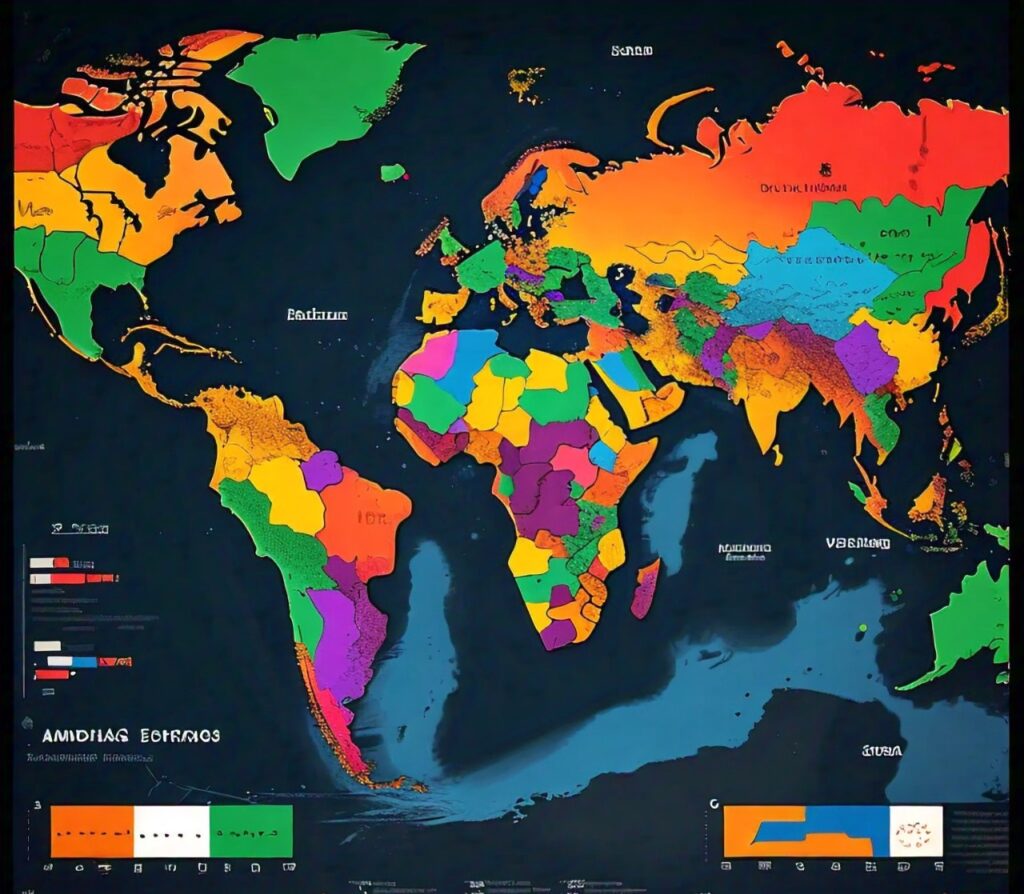Emerging markets, often characterized by rapid economic growth, industrialization, and increasing investment opportunities, represent a vital segment of the global economy. These markets are typically defined by their developing infrastructure, burgeoning middle class, and evolving financial systems. Recent years have seen these economies becoming increasingly significant, both as manufacturing hubs and as emerging consumer markets.
The economic landscape of emerging markets has been dynamic, influenced by a combination of domestic policies, global economic trends, and technological advancements. For instance, countries like India and China have demonstrated impressive GDP growth rates, driven by both domestic consumption and foreign investments.
For business owners and entrepreneurs, the challenge lies in pinpointing the right markets and sectors that align with their strategic goals. This requires a deep dive into market research, understanding local consumer behaviors, and staying informed about geopolitical developments that could impact trade and investment. For instance, sectors such as technology, renewable energy, and infrastructure are particularly promising, as they are often supported by both local governments and international investors aiming to bolster economic growth in these regions.
As we delve deeper into the specifics of these opportunities, it’s essential to approach emerging markets with a nuanced understanding of both the risks and rewards. By doing so, businesses can position themselves to not only enter these markets successfully but also sustain and grow their presence in the long term.
Understanding Emerging Markets
Definition and Characteristics of Emerging Markets
Emerging markets are nations experiencing rapid economic growth and industrialization, often transitioning from low-income to middle-income status. These markets are characterized by increased economic productivity, rising consumer income, and greater integration into the global economy. Countries such as India, Brazil, Indonesia, and Nigeria exemplify this category, showing significant potential for investment and trade opportunities.
Emerging markets typically display several key characteristics:
- Rapid Economic Growth: Many emerging markets have growth rates that outpace those of developed economies. For instance, India and Vietnam are expected to maintain GDP growth rates well above the global average in the coming years.
- Demographic Advantage: A young and growing population is a common trait in these markets, which supports a burgeoning workforce and an expanding middle class with rising purchasing power.
- Market Liberalization: Many of these countries are liberalizing their economies, reducing trade barriers, and improving infrastructure to attract foreign direct investment (FDI). This creates a conducive environment for international businesses looking to expand.
Why Emerging Markets are Attractive
The attractiveness of emerging markets lies in their dynamic and rapidly expanding economies. For business owners and entrepreneurs, these markets offer several compelling advantages:
- Untapped Consumer Bases: The expanding middle class in countries like China and India represents a vast, underserved market. As disposable incomes rise, so does the demand for consumer goods, services, and technology, creating a fertile ground for businesses to introduce new products and services.
- High Growth Potential: Emerging markets are often at an early stage of their economic development cycle, meaning there is significant room for growth. Sectors such as technology, renewable energy, and infrastructure are particularly ripe for investment, driven by both government initiatives and private sector innovation.
- Cost Advantages: Labor and production costs in emerging markets are generally lower compared to developed countries, providing cost-efficient opportunities for businesses, particularly in manufacturing and service industries.
Also Read: Trade Wars: The Future and What Lies Ahead

Challenges and Risks
While the opportunities in emerging markets are substantial, they come with inherent challenges and risks:
- Political Instability: Many emerging markets face political uncertainty, which can lead to abrupt changes in regulations, trade policies, or economic conditions. Entrepreneurs must be prepared for these shifts and have strategies in place to mitigate potential risks.
- Regulatory Hurdles: Navigating the regulatory landscape in emerging markets can be complex, with varying levels of bureaucracy and differing legal standards from one country to another. Understanding local laws and compliance requirements is essential for success.
- Economic Volatility: Emerging markets are more prone to economic fluctuations, including currency instability and inflation, which can affect profitability and market stability. It’s crucial for businesses to hedge against these risks and remain flexible in their operations.
High-Growth Regions in Emerging Markets
Identifying the most promising regions within emerging markets is crucial for business owners and entrepreneurs seeking new opportunities. Different regions present unique opportunities based on their economic trajectory, sectoral strengths, and developmental needs. Here’s a look at some of the high-growth regions that stand out in the current global landscape:
Asia-Pacific Region
The Asia-Pacific region continues to be a powerhouse of economic growth, driven by a mix of large, established economies and rapidly developing markets.
- China and India: China remains a key player, especially in manufacturing and technology, although its growth rate has moderated. India, on the other hand, is experiencing robust growth, fueled by a large, young population and a booming tech sector. India’s digital economy, driven by increased internet penetration and a burgeoning startup ecosystem, is expected to contribute significantly to its GDP in the coming years (2Checkout Blog).
- Southeast Asia: Countries like Vietnam, Indonesia, and the Philippines are emerging as strong contenders, particularly in sectors such as manufacturing, electronics, and e-commerce. Vietnam, for example, has become a global hub for electronics manufacturing, attracting significant FDI from tech giants looking to diversify their supply chains away from China .
Latin America
Latin America is gaining attention due to its natural resources, growing middle class, and expanding tech sector.
- Brazil and Mexico: As the largest economies in Latin America, Brazil and Mexico offer substantial opportunities in sectors like agriculture, energy, and fintech. Brazil’s agribusiness sector is a global leader, while Mexico is benefiting from nearshoring trends, making it a key destination for manufacturing investments .
- Chile and Colombia: These countries are emerging as leaders in renewable energy and technology. Chile, for instance, is a global leader in solar energy production, while Colombia’s tech sector is growing rapidly, supported by a robust startup ecosystem and increasing internet penetration .
Africa
Africa represents one of the last frontiers of significant untapped potential, with several countries showing impressive economic growth.
- Nigeria and Kenya: Nigeria is Africa’s largest economy, driven by its oil sector, but it is also seeing growth in fintech and telecommunications. Kenya, known as the “Silicon Savannah,” is a hub for technology innovation and mobile banking, with companies like Safaricom leading the charge in mobile money .
- Ethiopia and Rwanda: Ethiopia has one of the fastest-growing economies in the world, driven by investments in infrastructure and manufacturing. Rwanda, meanwhile, is becoming a leader in ICT and clean energy, attracting entrepreneurs and investors with its business-friendly policies and focus on sustainability .
Eastern Europe
Eastern Europe offers opportunities in sectors like IT services, manufacturing, and renewable energy.
- Poland and Hungary: Poland’s economy is one of the strongest in the region, with a growing IT services sector and a thriving startup scene. Hungary is also becoming a hub for automotive manufacturing and renewable energy, driven by favorable government policies and EU funding (2Checkout Blog).
- Baltic States: Estonia, Latvia, and Lithuania are becoming known for their innovation in IT services, digital governance, and fintech. Estonia, in particular, is a leader in e-governance and cybersecurity, making it an attractive destination for tech investments (2Checkout Blog).
Middle East
The Middle East is diversifying its economies beyond oil, with significant investments in technology, real estate, and renewable energy.
- United Arab Emirates (UAE) and Saudi Arabia: The UAE continues to attract investment in real estate, tourism, and technology, driven by its strategic location and business-friendly environment. Saudi Arabia, under its Vision 2030 plan, is investing heavily in infrastructure, technology, and renewable energy, aiming to reduce its dependency on oil and create a more diversified economy .
- Qatar: Qatar is emerging as a leader in infrastructure and sports, driven by preparations for major global events like the FIFA World Cup. The country is also investing in technology and renewable energy as part of its long-term economic strategy.
Also Read: How Trade Sanctions Are Affecting Global Markets

Sectoral Opportunities in Emerging Markets
As emerging markets continue to evolve, certain sectors stand out for their potential to offer significant returns on investment. Understanding these sectoral opportunities allows business owners and entrepreneurs to target their efforts where growth is most likely to occur. Below are some of the key sectors that are driving economic expansion in emerging markets:
Technology and Innovation
- Digital Transformation: The rapid digitalization in emerging markets is creating vast opportunities in technology. Countries like India, Brazil, and Nigeria are seeing exponential growth in their tech sectors, driven by increased internet penetration and mobile connectivity. The rise of fintech, e-commerce, and SaaS (Software as a Service) are particularly notable, as these technologies offer scalable solutions to large, underserved populations. In India, for instance, the fintech sector is expected to grow at a compound annual growth rate (CAGR) of 22.7% from 2020 to 2025 (2Checkout Blog).
- Artificial Intelligence and Machine Learning: As businesses in emerging markets adopt AI and ML to streamline operations and enhance customer experiences, there is a growing demand for AI-driven solutions. Southeast Asian countries like Vietnam and Indonesia are seeing a surge in AI startups focused on areas such as logistics, finance, and healthcare (2Checkout Blog).
Consumer Goods and Retail
- Expanding Middle Class: The growth of the middle class in countries such as China, India, and Indonesia is driving demand for consumer goods. This shift is creating opportunities for companies in sectors like food and beverages, personal care, and fashion. In China, the consumer goods sector is expected to benefit from the government’s focus on boosting domestic consumption as part of its “dual circulation” strategy (2Checkout Blog).
- E-commerce: E-commerce is booming in emerging markets, particularly in regions like Southeast Asia and Latin America. The convenience and accessibility of online shopping, combined with the expansion of digital payment solutions, are driving growth. In Indonesia, the e-commerce market is projected to reach $53 billion by 2025, making it one of the largest in the world (2Checkout Blog).
Manufacturing and Industrial
- Shift in Global Supply Chains: As companies look to diversify their supply chains beyond China, countries like Vietnam, India, and Mexico are becoming attractive destinations for manufacturing. Vietnam, in particular, has emerged as a hub for electronics manufacturing, benefiting from trade tensions between the U.S. and China (2Checkout Blog). India is also positioning itself as a manufacturing powerhouse, with government initiatives like “Make in India” aimed at boosting the sector.
- Automotive Industry: Emerging markets are increasingly becoming key players in the global automotive industry. Mexico is a major exporter of vehicles to the United States, while Thailand is known as the “Detroit of Asia” due to its robust automotive manufacturing sector. Electric vehicles (EVs) are also gaining traction, with countries like China leading in both production and adoption (2Checkout Blog).
Agriculture and Food Production
- Agribusiness Opportunities: With large swaths of arable land and favorable climates, emerging markets in Africa and Latin America are seeing growth in agribusiness. Brazil, already a global leader in soy and beef production, is investing in sustainable farming practices to increase yields and reduce environmental impact. In Africa, countries like Nigeria and Kenya are focusing on improving food security through innovations in agriculture technology and increased investment in food processing (2Checkout Blog).
- Sustainable Practices: The push for sustainability is opening up opportunities in organic farming, fair trade, and eco-friendly food production. Consumers in emerging markets are becoming more environmentally conscious, driving demand for sustainably produced food products (2Checkout Blog).

Further Read: Why Emerging Markets Are the Next Frontier in International Trade
Energy and Infrastructure
- Renewable Energy: The transition to renewable energy is a key focus for many emerging markets as they seek to reduce dependency on fossil fuels and meet global climate commitments. Countries like India, Brazil, and South Africa are leading the way in solar and wind energy installations. For example, India has set ambitious targets to increase its solar power capacity to 280 GW by 2030 (2Checkout Blog).
- Infrastructure Development: Rapid urbanization in emerging markets is driving demand for infrastructure development, including transportation, housing, and utilities. China’s Belt and Road Initiative (BRI) is a significant driver of infrastructure projects across Asia, Africa, and Europe, providing opportunities for businesses involved in construction, engineering, and related industries (2Checkout Blog).

How to Identify the Right Market Opportunities
Successfully identifying market opportunities in emerging markets requires a strategic approach. Business owners and entrepreneurs must consider various factors to ensure they are making informed decisions that align with their business goals. Here’s a comprehensive guide on how to identify the right market opportunities within these high-growth sectors:
1. Conduct Thorough Market Research
- Understand Local Demand: The first step in identifying market opportunities is understanding the local demand in the target region. This involves analyzing consumer behavior, preferences, and spending patterns. For instance, in countries with a growing middle class, there might be increased demand for consumer goods, healthcare, and financial services. Tools like market surveys, focus groups, and data analytics can provide valuable insights into these trends (2Checkout Blog).
- Analyze Competitors: Assessing the competitive landscape is crucial. Identify who the key players are in the market, what they offer, and how they are positioned. Understanding the strengths and weaknesses of competitors can help you identify gaps in the market that your business can exploit. This analysis can also reveal potential barriers to entry, such as high levels of competition or regulatory challenges (2Checkout Blog).
2. Evaluate Economic Indicators
- GDP Growth and Economic Stability: Look at the economic indicators of the region, including GDP growth, inflation rates, and currency stability. A market with strong economic growth and stability is more likely to offer sustainable opportunities. For example, countries like Vietnam and Ethiopia, with consistently high GDP growth, are attractive markets for investment (2Checkout Blog).
- Sector-Specific Growth: Focus on sectors that are showing significant growth in the region. For instance, the technology sector in Southeast Asia or renewable energy in Latin America are areas where rapid development is taking place. Sector-specific reports and economic forecasts can provide insights into which industries are poised for growth (2Checkout Blog).
3. Assess Political and Regulatory Environment
- Political Stability: The political environment in a country can have a significant impact on business operations. Markets with stable governments and clear, business-friendly policies are generally safer bets. Conversely, regions with political instability may pose risks such as sudden changes in regulations or disruptions due to civil unrest (2Checkout Blog).
- Regulatory Requirements: Understanding the legal and regulatory landscape is essential. Some emerging markets have complex regulatory environments that can create challenges for foreign businesses. It’s important to ensure that your business complies with local laws, including those related to taxation, labor, and trade. Engaging with local legal experts or consultants can help navigate these complexities (2Checkout Blog).
Practical Steps for Entering Emerging Markets
Once you’ve identified the right market opportunities, the next step is to develop a strategic plan for entering and establishing a presence in these emerging markets. This section outlines practical steps to help business owners and entrepreneurs effectively navigate this process:
1. Develop a Market Entry Strategy
- Direct Exporting: One of the simplest ways to enter an emerging market is through direct exporting. This involves selling your products or services directly to customers in the target market. While this approach minimizes investment risk, it also requires a strong understanding of local demand, distribution channels, and compliance with import regulations (2Checkout Blog).
- Licensing and Franchising: Licensing allows a local business to use your company’s intellectual property, such as patents, trademarks, or technology, in exchange for a fee. Franchising is another option, where a local franchisee operates your business model under your brand name. Both approaches are cost-effective ways to expand without the need for significant capital investment, though they require careful selection of partners to maintain brand integrity (2Checkout Blog).
- Joint Ventures and Partnerships: Forming a joint venture with a local company can provide a faster and more secure market entry, especially in markets with complex regulatory environments. Partnerships allow you to leverage local expertise, share risks, and gain easier access to distribution networks. However, success in joint ventures depends on finding a partner whose interests align with your long-term business goals (2Checkout Blog).
Also Read: The Impact of Trade Deficits on National Economies
Conclusion
Investing in emerging markets offers significant opportunities due to their rapid economic growth, evolving market dynamics, and promising sectors such as technology, consumer goods, healthcare, renewable energy, and financial services. These markets present unique growth potential for investors willing to navigate their complexities and risks.
Effective investment strategies involve choosing between direct and indirect investment approaches, employing diversification to manage risk, and continuously monitoring market conditions. Learning from both successful investments and past failures highlights the importance of thorough research, local market understanding, and adaptability.
By following these steps, business owners and entrepreneurs can better navigate the complexities of emerging markets and position themselves for sustainable growth. As you move forward, remember that success in these markets often requires a combination of strategic planning, local insight, and the ability to adapt to an ever-changing environment.






